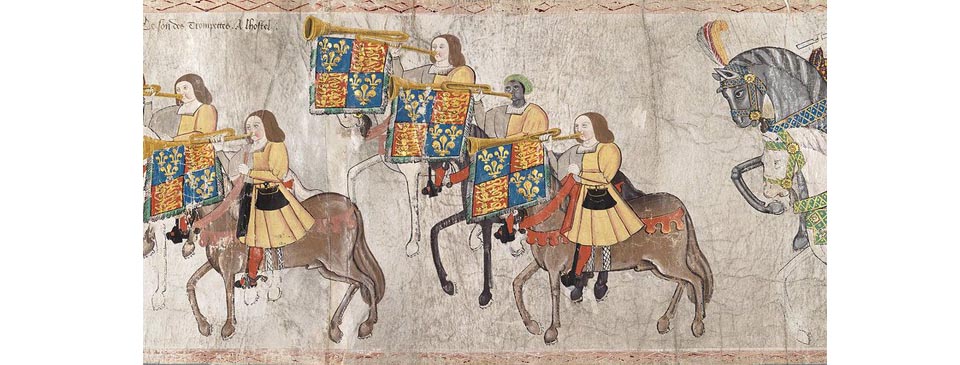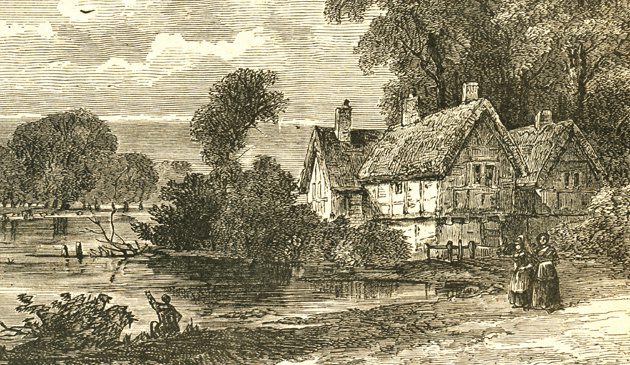Africans in London in the 16th century and the early slave trade

Africans were certainly living in England by the 16th century. A confirmation is within the Westminster Tournament Roll of 1511 where John Blanke is depicted as one of Henry VIII’s trumpeters.
European nations primarily used slaves for working on plantations in their colonies in the Americas. The English only created colonies in North America and the West Indies in the 17th century, long after the Spanish and Portuguese. That did not prevent English privateers of the Elizabethan period becoming interlopers in the African slave trade. Yet, at the same time, Africans began to live freely in London and elsewhere in the country.
Since at least as far back as the ancient Egyptians, Greeks, Romans, and Vikings slavery has provided labour for difficult, dangerous, tedious, or menial tasks. The word ‘slave’ is derived from ‘Slav’, which refers to the Slavonic people of Eastern Europe who were enslaved by Spanish Muslims during the 9th century. The Anglo-Saxons of medieval England used slaves as rural workers such as ploughmen.
As the manorial system evolved, slavery was replaced by serfdom but English churches continued to hold slaves until the early 12th century, with Peterborough Abbey using them as oxherds as late as the 1120s. Under the feudal system the class of subjects known as villeins were legally captive and bound to the lord of the manor. In 1485 at least 400 manors in England and Wales had villeins and, although it gradually dwindled, villeinage continued to exist until the 16th century.
Slavery continued in southern Europe, especially after the Black Death of the 14th century caused a great shortage of labour. Slaves were taken from Muslim North Africa and further afield, often traded by Italians from Genoa and Venice. It was enshrined in law in Spain as part of the Partidas statutory codes that were created during the reign of King Alfonso X in the 13th century and that were later to have a great significance in Latin America from the 16th century.
Slavery was widespread in the Islamic world where it was acceptable to enslave any non-Muslims. As Islam spread further across North Africa, Islamic traders looked further south to sub-Saharan regions and thus it became accepted that black Africans were ideally suited for slavery. Following his conquest of the Songhai Empire in present-day Mali in 1578, an annual tribute of 1,000 slaves was provided to Ahmed al-Mansur (Ahmed the Victorious) of Morocco.
The south coast of England was prey to Barbary pirates from Algiers, Tunis and Tripoli. As late as 1625 sixty men, women and children were captured and taken into slavery from St. Michael’s Mount in Cornwall.
Pope Eugenius IV had decreed in 1435 that anyone enslaving a person who had been baptised as a Christian would be excommunicated but that did not apply to non-Christian Africans.
Middle Eastern kingdoms controlled overland trade routes to Asia, with merchants bringing spices and other commodities. That was largely brought to an end during the conflicts known to Europeans as the Crusades. Blocked from purchasing Asian products, the Portuguese sought a sea route to the Far East and their exploration took them ever further down the west coast of Africa, where they traded with the Benin Empire.
By 1444 the Portuguese were returning from Africa with slaves, purchased from merchants at coastal ports. Goods were exchanged for slaves brought from deep inside Africa. By the 1460s the Portuguese were buying slaves in places such the Niger Delta and modern-day Angola.
In the late Middle Ages the Mediterranean island of Cyprus began producing sugar on plantations using slaves for the tough manual labour. The Portuguese and Spanish began to settle on islands off the coast of Africa, such as the Canaries, Cape Verde Islands, and Madeira where they also cultivated sugar cane, using African slaves. Europeans soon discovered the delights of sugar, making it a highly-lucrative crop.
In 1492 Christopher Columbus sailed west, sponsored by King Ferdinand and Queen Isabella of Spain. It was the starting point of European colonisation of the Americas where the Spanish and Portuguese discovered the fabulous wealth of the Aztecs and Inca empires. In the Treaty of Tordesillas of 1494 Spain laid claim to most of the New World of South America and the Caribbean, while Portugal held trading rights with Africa and the Far East, and colonisation of Brazil.
Sugar cultivation was attempted in the New World, and gold and silver mines dug. The indigenous peoples were enslaved to carry out the work but were unsuitable for the tough work and the death rate was high from imported diseases. Therefore, from 1502 African slaves were transported across the ocean, using the colonised Atlantic islands as staging posts. Some died on the sea journey, and others from the harsh labour conditions, while a few escaped into the mountains, and thus a continuous slave trade was necessary to resupply the labour force.
Lacking trading posts in mainland Africa, from the early 16th century the Spanish licensed the supply of slaves for their colonies to Portuguese and other merchants in agreements known as the Asiento de Negros. Thus, the trading of slaves to the Americas became a commercial and licensed proposition.
The slave business evolved into a triangular trade. Ships sailed from Portugal (and later other European countries) with goods that could be exchanged with African merchants for slaves. The human cargo was then transported to the Americas where the slaves were sold in return for sugar, which was sailed back to Europe.


